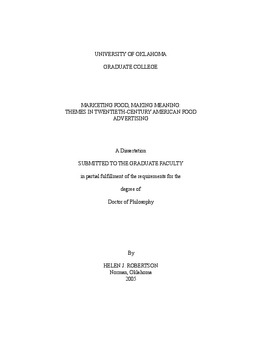| dc.contributor.advisor | Offen, Karl, | en_US |
| dc.contributor.author | Robertson, Helen J. | en_US |
| dc.date.accessioned | 2013-08-16T12:20:01Z | |
| dc.date.available | 2013-08-16T12:20:01Z | |
| dc.date.issued | 2006 | en_US |
| dc.identifier.uri | https://hdl.handle.net/11244/973 | |
| dc.description.abstract | Though both advertising and the idea of nature are ubiquitous in American culture, little work has been done to examine how the former constructs the latter. Advertising is everywhere, and nature is everywhere in advertising---as a background, a concept, a place, a commodity. This study uses advertising for food in magazines from 1920-1975 as an entry point into an exploration of the narratives of nature used by the advertising industry over a 50-year period to frame the themes used to market foods. It describes how four different themes, memory, place, health, and convenience, were used throughout this period in food advertising, and how each of these themes embodies different narratives of nature. These narratives include nature as an idyllic past, nature as a paradise or pastoral setting, fresh and untouched, nature as both a good raw material and a dangerous threat, and nature as a lifestyle problem. | en_US |
| dc.format.extent | ix, 230 leaves : | en_US |
| dc.subject | American Studies. | en_US |
| dc.subject | Advertising Food. | en_US |
| dc.subject | Business Administration, Marketing. | en_US |
| dc.subject | Geography. | en_US |
| dc.subject | Agriculture. | en_US |
| dc.title | Marketing food, making meaning: Themes in twentieth-century American food advertising. | en_US |
| dc.type | Thesis | en_US |
| dc.thesis.degree | Ph.D. | en_US |
| dc.thesis.degreeDiscipline | Department of Geography and Environmental Sustainability | en_US |
| dc.note | Source: Dissertation Abstracts International, Volume: 67-01, Section: A, page: 0291. | en_US |
| dc.note | Adviser: Karl Offen. | en_US |
| ou.identifier | (UMI)AAI3206133 | en_US |
| ou.group | College of Atmospheric & Geographic Sciences::Department of Geography and Environmental Sustainability | |
